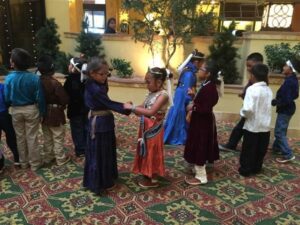Local involvement in JOM lacking
Retaining leadership in Johnson O’Malley difficult
RAPID CITY—Back in 1934 the Johnson-O’Malley Act authorized federal funding for Native students enrolled in nontribal schools, whether public or private. This involves an education plan approved by the Bureau of Indian Education (BIE), which according to the Johnson-O’Malley (JOM) website “educational objectives to address the needs of eligible” Native students. This program is localized to various regions around the country, but there has been a participation problem for Lakota tribes in our Region 4. The person that was there vacated,” said Petra Wilson, a national JOM Region Seven representative (Nevada, Utah, California), and an enrolled member of the Oglala Sioux Tribe. “That’s an open position.”
Wilson says a prospective member will have to “attend a caucus and fill out a form for candidacy.” Candidates will receive a stipend but it is a volunteer position, which is often filled by those involved in JOM programs, or as in the case of Wilson herself, a parent advocate that has spent a couple of decades involved in JOM processes, and is self-educated on policy and procedure. : “South Dakota, North Dakota, Nebraska,” Wilson said, “we typically have maybe one person show interest or nobody runs. This year nobody ran.”
Wilson explains how she got involved with JOM: “I started participating as a representative on an Indian Education committee, and then I moved into chair, and I served as chair for three terms in the Clark County School District (Nevada). During that time, I began to research what Johnson-O’Malley was, what Indian Education was doing, just learning what I could do and what my part was in being a parent to Native American students. I taught myself how to understand federal regulations, the budgeting process with the school district, just whatever I could do to make sure our kids were being represented.”
Concerning the difficulties of attracting and retaining leadership in JOM Region Four, Wilson said: “Considering how large (Region Four) is, the size of the tribes and the number of kids that are there for advocacy, the attendance at the conference is not as good as expected. “
Wilson stresses that even though Region Four is not her direct concern, “if there are needs I hear from people from my own tribe, I will speak up for them. I do try to still help any tribe that approaches me.” Because of that willingness to advocate outside her region, the lack of a Region Four representative has been alleviated, but informed, direct representation, given the depths of the bureaucracy of the BIE and Johnson-O’Malley, over time, will be critical.
According to the federal website: “Johnson O’Malley programs offered to American Indian and Alaska Native students vary and may include such programs as culture, language, academics and dropout prevention. Johnson-O’Malley funds under this program may not be used for capital expenditures. Eligible applicants are tribal organizations, Indian corporations, school districts or States with eligible American Indian and Alaska Native children attending their schools or public school districts that have established Indian Education Committees to approve supplementary support programs that benefit American Indian and Alaska Native students.”
Since the JOM program was implemented, there has been an ongoing struggle to establish equitable parameters for which students are eligible for funding. For the longest time it was ¼ blood quantum, but the latest change has been ¼ blood quantum in lieu of evidence of direct descendancy or tribal enrollment.
“Eligible American Indian and Alaska Native students,” reads JOM’s updated mission statement, “are enrolled members of a federally recognized tribe or at least one-fourth or more degree of Indian blood descendant of a member of a federally recognized Indian tribal government eligible for services from the Bureau. In addition, eligibility requires these children be between age 3 through grades 12, with priority given to children residing on or near an Indian reservation.”
JOM’s current funding formula is easy to factor. For example, there are about 2,600 Native students in the Rapid City School District. You first take the average per pupil operating cost, either by the individual state, or the national average, whichever is higher, and if we assume Rapid City’s average cost is lower, the national average is #13,000. This money is then multiplied by 25 percent and then multiplied by the number of students. Which means Rapid City would receive about $8.5 million in JOM funding.
Given so much money is involved, concerned members of the Rapid City Indian Community should become involved enough to have an accounting of how the Rapid City School District allocates and spends JOM funds. Advocates can get started in much the same way Wilson did, on a local Indian Education committee. From there, attending JOM regional meetings, and familiarizing yourself with policy and procedure, can prepare you to file for candidacy and become the Region Four representative.
(Contact James Giago Davies at skindiesel@msn.com)
The post Local involvement in JOM lacking first appeared on Native Sun News Today.

